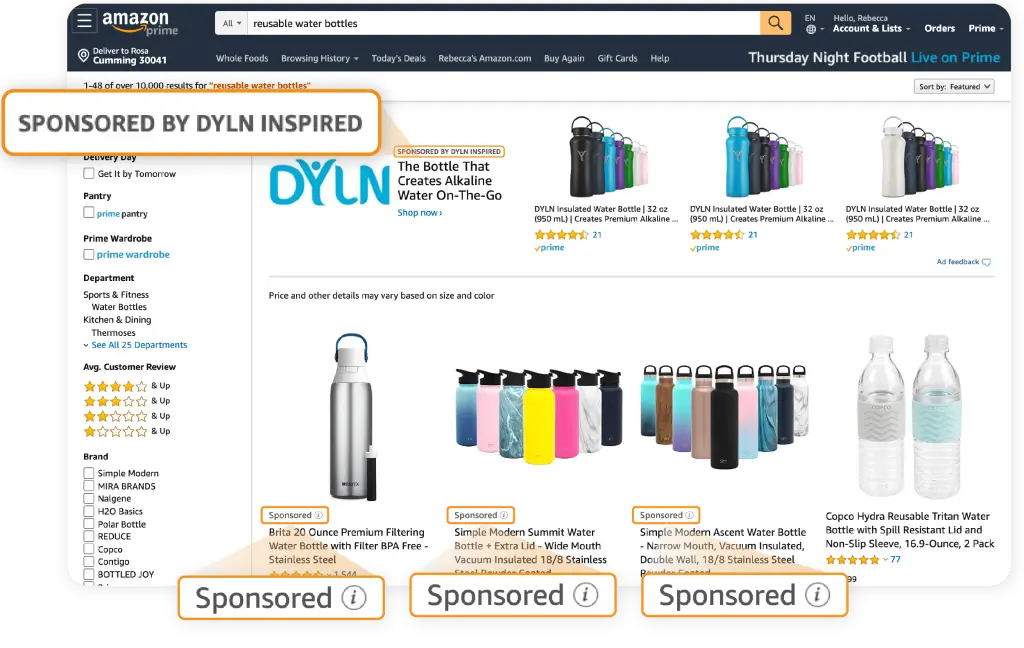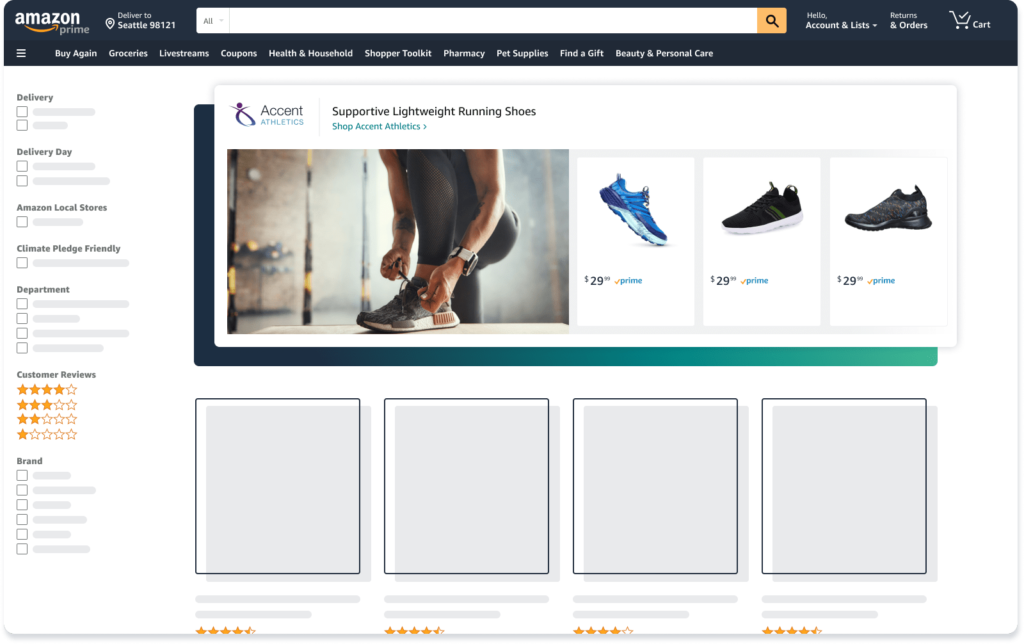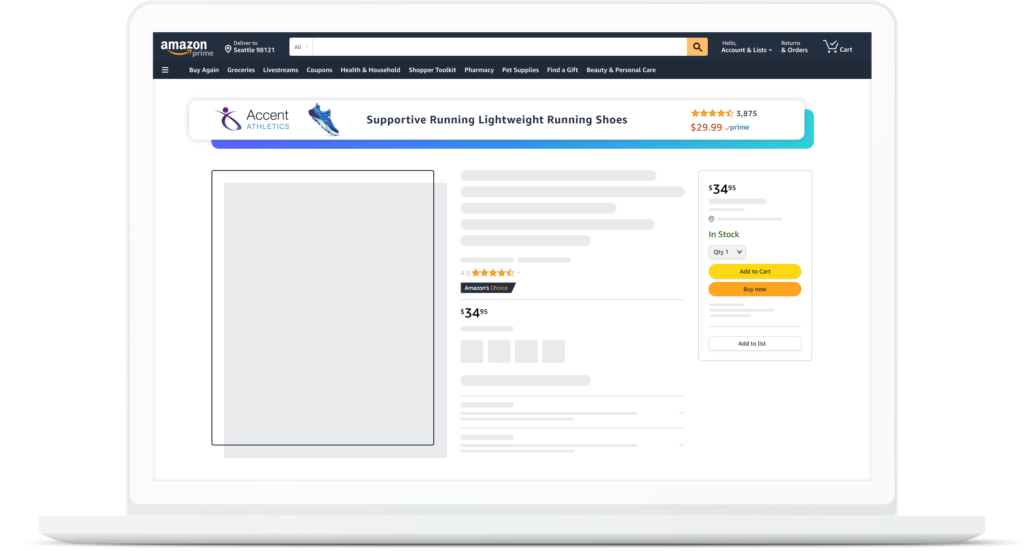As an Amazon seller, you’ve likely heard the term “PPC” thrown around. But what is Amazon PPC, exactly? And why is it so crucial for your business? By now, you may have heard how PPC can skyrocket your business to a new level by driving visibility and sales on the world’s largest e-commerce marketplace in a way that just isn’t possible with organic sales.
However, Amazon PPC can also be complex and intimidating, especially for new sellers just starting out. With so many factors to consider—from keyword research to bid management to Amazon PPC optimization—it can be challenging to know where even to begin.
That’s why we’ve put together this helpful guide to Amazon PPC for beginner sellers. Below, we’ll cover the basics of how Amazon PPC works, explain the different campaign types available, and provide actionable tips to help you get the most out of your advertising budget. By the end, you’ll gain a solid understanding of Amazon PPC, equipping you to drive more traffic and sales to your product listings.
Let’s get started!
Amazon PPC Explained
What Is Amazon PPC Advertising?
Amazon PPC advertising is a pay-per-click model where sellers pay each time a shopper clicks their ad on search results pages. It increases product visibility by placing ads alongside organic results, this increases the likelihood shoppers will discover, click, and purchase products.
For example, if you sell yoga mats, you can bid on keywords like “best yoga mat” or “non-slip yoga mat” to have your product appear when shoppers search for these terms. The cost-per-click (CPC) varies depending on the competition for the keyword, but the goal is to generate enough sales from these clicks to outweigh the advertising cost.
In short, the PPC setup is attractive to sellers because, unlike other forms of advertising, such as television commercials or billboards, you only pay when a customer clicks on your ad.
Why PPC Ads Are Important for Your Amazon Business
First and foremost, Amazon PPC ads help increase the visibility of your products. With millions of products across the platform, it’s easy for new sellers to get lost in the crowd. Amazon PPC allows you to push your listings to the top of the search results, ensuring that the right shoppers see your products at the right time.
Secondly, PPC advertising on Amazon can significantly improve sales. When done effectively, your ads will target relevant keywords and audiences, funneling interested buyers directly to your product pages. If your product, pricing, and ability to communicate that your product is the one the customer needs appeal to your audience, this translates to more clicks, conversions, and, ultimately, revenue for your Amazon business.
Do you know how amusement parks like Disneyworld have a “FastPass” for attendees to skip long lines? Just as those theme park FastPasses allow attendees to bypass the long lines and get straight to the thrilling rides, Amazon PPC functions as a seller’s FastPass to jump to the front of the proverbial line on the Amazon marketplace. Without it in your marketing mix, it might take a little more time and energy to climb the ranks and maintain organic ranking in the long run. Unlike a FastPass, PPC can have lasting impacts, as increased performance with sales and customer reviews can have a long-term effect on your visibility and sales.
Additionally, Amazon PPC data provides invaluable insights that can inform your overall product and marketing strategy. By closely monitoring metrics like click-through rate, conversion rate, and advertising cost of sales, you can identify your best-performing products, refine your keyword targeting, and allocate your ad budget more efficiently. While these data points may not improve your bottom line immediately, they can be incredibly powerful in the long run.
How Amazon PPC Works
At its core, Amazon PPC is an auction-based system that determines when and where your ads appear on the platform.
- Choose Your Products: Start by selecting the products you want to advertise.
- Select Keywords: You’ll need to identify relevant keywords that potential buyers might use when searching for products. These keywords are crucial because they determine when your ads will be shown.
- Set Your Bid: You set a maximum bid for each keyword, the highest amount you’re willing to pay for a click. The more competitive the keyword, the higher the bid you may need to set to have your ad displayed.
- Ad Placement: Your ads can appear in various locations on Amazon, such as at the top of search results, on product detail pages, or in other prominent areas. The placement is influenced by your bid and the relevance of your product to the search term.
- Monitor Performance: Once your campaign is running, you can track its performance through metrics like impressions, clicks, and sales generated from those clicks.
Key Terms to Know
Additionally, Here’s a closer look at how the system functions and some key terms you need to know.
- CPC (Cost-Per-Click): The amount you pay when someone clicks on your ad.
- CTR (Click-Through Rate): The percentage of people who click on your ad after seeing it.
- ACoS (Advertising Cost of Sales): A metric that shows the efficiency of your ad spend, calculated as ad spend divided by sales generated from ads.
PPC can be intimidating for the uninitiated because it can feel like learning a new language, with acronyms and initialisms aplenty. Check out our Amazon PPC glossary to learn the language and avoid getting lost in translation.
Types of Amazon PPC Ads
There are three Amazon PPC marketing types, each serving different purposes depending on your advertising goals.
Sponsored Products

Amazon Sponsored Products are the most common type of Amazon PPC ad. They appear in search results and on product detail pages, making them highly visible. This ad type is ideal for promoting individual products and boosting sales quickly. For example, if you’re launching a new product or want to increase the visibility of a best-seller, Sponsored Products can help you achieve those goals.
Sponsored Brands

Formerly known as Headline Search Ads, Sponsored Brands ads allow sellers to showcase their brand logo, a custom headline, and multiple products. These ads appear at the top of search results and are perfect for increasing brand awareness. If you have a line of complementary products, Sponsored Brands can help you promote them together, driving more traffic to your Amazon Store or custom landing page.
Sponsored Display Ads

Sponsored Display Ads enable you to reach customers both on and off Amazon. These ads appear on product detail pages, customer review pages, and even third-party websites like Twitch and IMDB. Sponsored Display Ads are great for retargeting shoppers who have previously viewed your products, helping to keep your brand top of mind and encouraging repeat visits.
How To Set Up Your First Amazon PPC Campaign
Campaign Structure
Creating a well-organized Amazon PPC campaign structure is key to maximizing PPC performance. A thoughtful structure will help you achieve your personal goals and efficiently manage and optimize your campaigns over time.
How to Structure a Campaign for Success
- Product Categories: Group products into separate campaigns or ad groups based on their categories. For example, if you sell various fitness products, you might create separate campaigns for yoga mats, dumbbells, and resistance bands. This allows you to tailor your keyword targeting and bidding strategies more effectively.
- Targeting Strategies: Decide between automatic and manual targeting. Automatic targeting lets Amazon choose keywords for you, which is helpful when starting out. Manual targeting gives you full control over the keywords, bids, and overall strategy, allowing for more precise targeting as you gain experience.
- Ad Groups: Organize products into ad groups within each campaign based on similar attributes or goals. For example, if you sell multiple colors of the same product, group them together. This helps you manage bids and budgets more efficiently.
Choosing the Right Keywords
Another Amazon PPC strategy involves choosing the right keywords, which is critical to the success of your Amazon PPC campaign. The goal is to target keywords that are highly relevant to your products and have a strong potential to convert into sales.
Amazon allows three unique actions when targeting Amazon PPC keywords: broad match, phrase match, and exact match.
Broad, Phrase, and Exact Match Types:
- Broad Match: Your ad will appear for searches that include any part of your keyword in any order. This is the most flexible match type and helps you discover new keyword opportunities, but it can lead to irrelevant clicks.
- Phrase Match: Your ad will appear for searches that contain the exact sequence of your keywords, but other words can be added before or after. This type offers a balance between reach and relevance.
- Exact Match: Your ad will only appear when the exact keyword or a close variant is searched. This provides the most control but limits your reach to only the most specific searches.
Amazon provides suggested keywords and limited keyword data. However, our Keyword Research tool goes further by offering keyword insights related to your product and its listing. We provide advanced metrics such as relevance score, priority score, and search volume estimates. These are compiled using data from the Amazon marketplace and our best-in-class formula for estimating search volume. Keyword Research can help you gain an advantage over the competition and become a keyword wizard.
Setting Your PPC Budgets & Bids
Setting up Amazon PPC budgets and bids properly is crucial to ensuring your PPC campaigns are cost-effective and competitive.
Tips and Guidelines for Setting Effective Budgets and Competitive Bids
- Daily Budgets: Start with a modest daily budget you are comfortable spending. Monitor your campaigns regularly and adjust your budget based on performance. As you gain more data, you can increase your budget to capitalize on high-performing campaigns.
- Default Bids: Amazon will suggest a default bid based on competition and keyword relevance. This can be a good starting point, but consider testing higher or lower bids to find the sweet spot where you get enough clicks without overspending.
- Bid Adjustments: Adjust bids based on time of day, device type, or other factors influencing purchasing behavior. For instance, try Amazon bidding strategies such as increasing bids during peak shopping hours or for mobile users if your product performs well in those segments.
- ACoS (Advertising Cost of Sales): Aim for a target ACoS that aligns with your profit margins. For instance, if you have a 30% profit margin on a product, your target ACoS should ideally be below 30%. This ensures you’re not spending more on ads than you earn from sales.
By following these steps and guidelines, you’ll be well on your way to creating an effective Amazon PPC campaign that drives traffic, boosts sales, and grows your business.
Pro Tip
Master these tips and more with our AdSprout PPC tool! Complete with personalized recommendations and automation using comprehensive data from the Amazon marketplace and your own product performance, AdSprout PPC management makes it easier to level up your advertising game. From rule-based automation that can shut off unprofitable campaigns or enhance spending on profitable ones to enhanced reporting to refine your game over the long run, AdSprout helps you boost sales performance and gain market share.
Best Practices for Amazon PPC Success
Optimize Product Listings
Your PPC performance is directly tied to the quality of your product listings. Your PPC bids may land you in a prime position to be seen, but your product and listing are crucial for converting views into sales.
Invest in premium, professional product photography that highlights your product. Ensure your titles, bullet points, and descriptions are keyword-rich and compelling. A well-optimized listing improves your ad relevance and conversion rates. All in all, your product photography and listing should answer any questions a customer might have about your product and quell any concerns a customer might have before adding to cart.
You can check your top competitors’ listings for any relevant information that customers might be interested in. For inspiration, you can peruse customer reviews to see what customers loved and what left them with a sour taste in their mouths after purchasing a product. Be sure to include this information in your listing to duplicate their success or swerve away from their shortcomings.
Continuous Keyword Optimization
One key to success with Amazon PPC is optimizing your keyword targeting. Unlike a one-and-done approach, effective keyword management requires vigilant monitoring and continuous refinement.
Your top-performing keywords can shift dramatically based on changes in customer search behavior, product trends, and competition on Amazon. That’s why it’s crucial to review the keyword data from your active PPC campaigns regularly. Look at metrics like click-through rate, conversion rate, and advertising cost of sales to identify your most vital keywords – the ones producing the highest volume of clicks and sales at the lowest cost. Then, double down by allocating more of your ad budget to these proven performers.
By staying on top of your keyword optimization game, you can prevent your competition from finding gaps in the keyword market, keep your products front and center for the right shoppers, and convert those clicks into sales.
Use Negative Keywords
Negative keywords are search terms that you actively exclude from triggering your ads, helping you avoid wasted spend on irrelevant traffic.
Think of negative keywords as the flip side of your target keyword strategy. Whereas you want your ads to show up for high-intent, converting search queries, negative keywords allow you to filter out searches unlikely to lead to sales. For example, if you’re selling men’s hiking boots, you may want to add “women’s” “kids,” or “cheap” as negative keywords to prevent your ads from showing up for those unrelated searches and driving up your ad spend inefficiently.
Incorporating negative keywords is crucial for refining the focus of your PPC campaigns and improving your advertising efficiency. Proactively blocking irrelevant traffic can redirect your ad budget toward the searches most likely to drive qualified leads and conversions. This not only boosts your return on ad spend but also improves the overall relevance of your ads, leading to higher click-through and conversion rates over time.
Final Thoughts On Amazon PPC
Amazon PPC is a powerful tool for driving sales and increasing visibility on the platform. While there’s a learning curve, the long-term benefits of PPC advertising can significantly impact your business’s growth.
Is Amazon PPC necessary for everyone? While sellers can certainly experience success without Amazon PPC in their selling mix, it’s highly unlikely a business can reach its peak without Amazon PPC advertising in its metaphorical toolbox. Is Amazon PPC worth it? Absolutely, as it can transform your business or take it to an entirely new level, propelling your visibility in the competitive marketplace and driving sales at a rate not realistically possible for most sellers without advertising.
With a well-planned approach and continuous optimization based on changing capabilities and market trends, PPC can become a powerful component of your overall business strategy, helping you reach new heights in your Amazon selling journey by improving product visibility, reaching new customers, and selling your products efficiently.
For even more Amazon PPC information, check out our post on the essentials of a successful Amazon ad campaign, or sign up for our free Amazon PPC playbook for a step-by-step guide to accelerate your business with advertising on Amazon.








